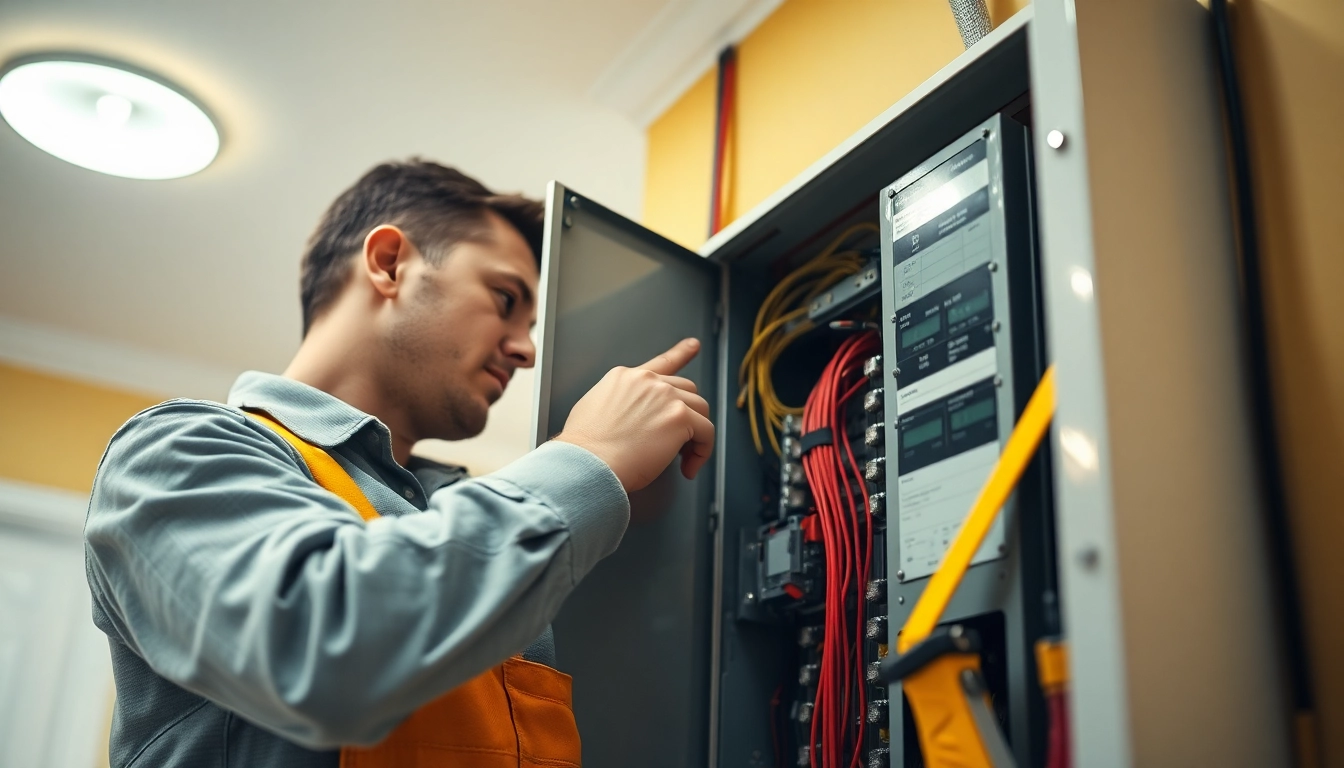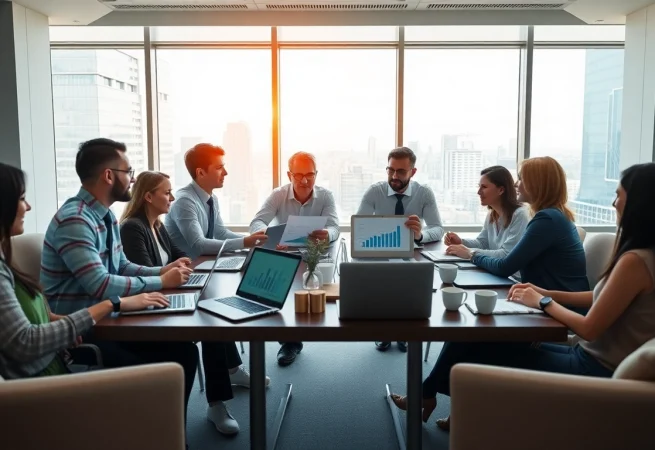

Leveraging Competitive Intelligence to Enhance Business Strategy and Performance
Understanding Competitive Intelligence
In a world of relentless competition and swiftly changing market dynamics, understanding the landscape of your business environment is crucial. This is where competitive intelligence comes into play. It enables organizations to gather, analyze, and disseminate important information that not only helps them understand their industry but also positions them strategically for future growth. To appreciate its significance fully, one must delve into the definition, importance, historical context, and common misconceptions surrounding this essential practice.
Definition and Importance of Competitive Intelligence
Competitive intelligence (CI) is defined as the systematic process of gathering, analyzing, and interpreting information regarding competitors, market trends, and overall industry dynamics. Unlike corporate espionage, which is unethical and illegal, CI adheres to legal and ethical standards, focusing on publicly available information and industry insights.
The importance of competitive intelligence lies in its ability to provide organizations with a strategic edge. By understanding competitors’ strengths and weaknesses, businesses can make informed decisions regarding product development, marketing strategies, and overall business operations.
Moreover, CI enhances an organization’s ability to anticipate market changes, react proactively to competitors, and identify emerging opportunities and threats. This foresightedness can lead to improved profitability, market share retention, and overall organizational stability.
Historical Context and Evolution of Competitive Intelligence
While competitive intelligence may seem like a modern business practice, its roots can be traced back to ancient times. Historically, merchants and traders have always sought knowledge about their competitors to gain an advantage. However, the formal practice of competitive intelligence began to develop in the United States during the 1960s and 1970s. Organizations recognized the need to systematically collect and analyze data about their competitors in a growing market economy.
As globalization began to take shape in the late 20th century, CI practices evolved significantly. The advent of digital technology transformed how data was collected, analyzed, and disseminated, making CI more accessible and crucial than ever. Today, companies utilize advanced software and analytical techniques to compile vast amounts of data, turning them into actionable insights.
Common Misconceptions About Competitive Intelligence
Despite its growing importance, several misconceptions surrounding competitive intelligence persist. One prevalent myth is that CI is primarily about spying on competitors. In reality, CI focuses on acquiring legal and ethical insights through market analysis, customer feedback, and public information.
Another misconception is that CI is only relevant for large corporations. On the contrary, businesses of all sizes can benefit from CI strategies tailored to their specific context and needs. Additionally, some believe that CI is solely about tracking competitors; however, it also encompasses understanding customer preferences, market trends, and regulatory environments that can influence business strategies.
Collecting Competitive Intelligence Data
Primary Sources of Data in Competitive Intelligence
Effective competitive intelligence relies on diverse sources of data. These sources can be categorized into primary and secondary data. Primary data involves collecting information directly from the source, such as interviews, surveys, and focus groups. This type of data can provide a firsthand perspective on customer sentiments and competitor strategies.
Secondary data consists of information that has already been collected and published by others. Common secondary sources include industry reports, market research studies, competitor websites, press releases, and social media channels. By triangulating both primary and secondary sources, organizations can create a comprehensive view of the competitive landscape.
Tools and Techniques for Gathering Insights
Numerous tools and techniques can aid organizations in gathering competitive intelligence. Online survey tools, such as SurveyMonkey and Google Forms, can help obtain primary data from customers regarding their experiences and preferences. Web scraping tools can efficiently gather competitive insights from websites, newsletters, and press releases.
Moreover, platforms like SimilarWeb and SEMrush provide a wealth of information on competitor website traffic, keywords, and audience demographics. Social listening tools such as Hootsuite can track brand mentions across social media, offering insights into public perceptions and sentiments.
Finally, business intelligence software enables organizations to consolidate and analyze data, facilitating the transformation of raw data into strategic insights.
Best Practices for Data Collection in Competitive Intelligence
To ensure effective data collection, several best practices should be adhered to. First, organizations need to establish clear objectives for their CI efforts. Defining what insights are necessary and how they will be used is crucial for guiding the data collection process.
Second, a systematic approach to data collection should be adopted. This means creating a structured process for gathering, analyzing, and presenting data, which can enhance consistency and reliability.
Furthermore, ensuring ethical standards throughout the data collection process is paramount. Respect for competitor privacy, as well as adherence to legal guidelines, fosters credibility and trust in competitive intelligence efforts.
Lastly, organizations should continually evaluate and update their data collection methods. As market dynamics change, so too should the tools and approaches utilized to gather intelligence.
Analyzing Competitive Intelligence Information
Methods of Analyzing Competitive Intelligence Data
The analysis of competitive intelligence data is where the transformation of raw information into actionable insights occurs. Several methods can be employed to analyze CI data effectively. SWOT analysis (Strengths, Weaknesses, Opportunities, Threats) is a popular framework that helps organizations evaluate their position relative to competitors.
Another method is trend analysis, which focuses on identifying patterns over time. By examining historical data, organizations can discern emerging trends and anticipate future changes in the market landscape. Data visualization tools, such as Tableau or Google Data Studio, can aid in presenting complex data in digestible formats for better stakeholder understanding.
Identifying Trends and Insights
The ultimate goal of analyzing competitive intelligence data is to identify trends that can guide strategic decision-making. For instance, shifts in consumer behavior can be discerned through analyzing customer feedback and competitor marketing efforts. Identifying these trends early allows organizations to adapt their offerings and strategies swiftly.
Additionally, monitoring competitors’ product launches, pricing strategies, and promotional campaigns can uncover insights into their positioning and tactics. This information can be instrumental in crafting more effective marketing and business strategies that resonate with target audiences.
Turning Data into Actionable Business Strategies
Data analysis must culminate in the creation of actionable strategies that propel the business forward. Organizations should ensure that insights derived from competitive intelligence inform various aspects of their operational processes, including product development, marketing strategies, customer engagement, and pricing frameworks.
Moreover, collaboration among various departments—such as marketing, sales, and product development—can enhance the effectiveness of strategic initiatives informed by competitive intelligence. By aligning these departments around CI insights, organizations can execute more coherent and cohesive strategies.
Implementing Competitive Intelligence in Your Organization
Steps to Develop a Competitive Intelligence Program
Establishing a competitive intelligence program involves several critical steps. Firstly, organizations must define their goals and objectives accurately. This includes understanding the specific insights required to improve decision-making processes. Next, a CI team should be formed, comprising members from different functions within the organization to bring diverse perspectives and expertise.
The development of a structured plan for data collection and analysis should follow. This plan should outline the tools, workflows, and timelines for gathering and interpreting intelligence.
Implementing a feedback loop is also essential. This enables the continual refinement of CI processes based on lessons learned and changing market conditions.
Integrating Competitive Intelligence into Business Processes
For a competitive intelligence program to succeed, it must be integrated into the organization’s broader business processes. This means embedding CI insights into regular decision-making frameworks at all levels of the organization. Regular presentations and updates can keep stakeholders informed of competitive insights and their strategic implications.
Additionally, creating a culture that values data-driven decision-making can enhance the impact of CI efforts. Encouraging team members to leverage competitive intelligence in their roles leads to more innovative solutions and strategies.
Measuring the Success of Competitive Intelligence Initiatives
Measuring the success of competitive intelligence initiatives is vital to understanding their effectiveness. Organizations can employ key performance indicators (KPIs) such as the accuracy of forecasts based on CI, the number of strategic decisions enhanced by CI insights, and the overall impact on market share and profitability.
Regularly reviewing these metrics allows organizations to assess the value generated from their competitive intelligence efforts and make necessary adjustments to optimize their strategies.
Future Trends in Competitive Intelligence
Emerging Technologies Impacting Competitive Intelligence
The future of competitive intelligence is heavily influenced by emerging technologies. As artificial intelligence (AI) and machine learning continue to advance, they hold the potential to revolutionize data collection and analysis processes. These technologies can automate the extraction of insights from vast volumes of data, enabling organizations to derive insights more efficiently and effectively.
Moreover, predictive analytics is becoming increasingly relevant in competitive intelligence. By leveraging historical data and identifying patterns, organizations can forecast competitive movements and market shifts, enabling proactive rather than reactive strategies.
The Role of AI and Machine Learning in Competitive Intelligence
AI and machine learning algorithms are poised to play a critical role in enhancing the accuracy and speed of competitive intelligence processes. For instance, natural language processing can analyze consumer sentiment across social media channels more efficiently, identifying key trends and insights from unstructured data.
Additionally, predictive models can assist organizations in not just reacting to competitors but anticipating their behaviors, allowing businesses to develop strategies that outmaneuver rivals before they can act. This proactive approach to competitive intelligence marks a significant shift from traditional methodologies.
Preparing for the Evolving Landscape of Competitive Intelligence
To remain competitive in the evolving landscape of competitive intelligence, organizations must adopt an adaptable mindset. This involves continually investing in CI tools and technologies, along with providing ongoing training for employees to enhance their analytical skills.
Furthermore, fostering a culture of innovation and agility can prepare organizations to pivot quickly in response to shifts in the competitive environment. Keeping abreast of industry trends and emerging technologies will ensure that competitive intelligence practices remain relevant and effective in the face of change.

Effective Strategies for Boosting Your Edmonton SEO Game
Understanding the Importance of Edmonton SEO
In the rapidly evolving digital landscape, a strong online presence is essential for businesses, especially for those operating in specific locales like Edmonton. One of the pivotal strategies in enhancing visibility and attracting potential customers is through edmonton seo. Effective SEO strategies enable local businesses not just to survive but to thrive in their markets by improving their search engine rankings and drawing the right audience.
The Role of SEO in Digital Marketing
Search Engine Optimization (SEO) is a cornerstone of digital marketing. It involves various techniques and tactics aimed at increasing the visibility of a website on search engines. By optimizing websites and content, businesses can enhance their organic search rankings, meaning they appear closer to the top when potential customers search for relevant keywords. SEO encompasses both on-page elements, such as document structure and keyword usage, as well as off-page factors like backlinks and social media engagement.
Why Edmonton SEO Matters for Local Businesses
For businesses in Edmonton, local SEO is not just beneficial, it’s essential. Edmonton SEO techniques directly contribute to higher visibility within local search results, connect businesses to their community, and draw in local customers who are in immediate need of their services. This local focus means that businesses can compete not just on a wide scale but effectively reach customers in their vicinity who are likely to convert from visitors into customers. In a city where multiple businesses may offer similar services, implementing effective Edmonton SEO can be the deciding factor for many prospective customers.
Key Trends Impacting Edmonton SEO
The digital marketing landscape is ever-changing, and SEO trends continuously evolve. Several key trends are currently influencing how businesses in Edmonton approach SEO:
- Voice Search Optimization: With the rise of voice-activated devices, optimizing for voice search is becoming crucial. People often phrase their search queries differently when speaking rather than typing.
- Mobile-First Indexing: Google’s mobile-first indexing means that the mobile version of a site is considered the primary version, making mobile optimization essential for SEO success.
- Artificial Intelligence and SEO: AI tools are increasingly being used for analyzing SEO trends and predicting what content will perform best in searches. Understanding and leveraging AI can give Edmonton businesses a competitive edge.
Identifying the Right Keywords for Edmonton SEO
Keyword research is foundational to any successful SEO strategy. For businesses in Edmonton, identifying local and relevant keywords can make a significant difference in attracting the right traffic.
Using Tools for Keyword Research
Utilizing tools specifically designed for keyword research can provide insights into what users are searching for online. Tools like Google Keyword Planner, SEMrush, and Ahrefs can help identify high-volume search terms relevant to Edmonton, enabling businesses to tailor their content effectively. It’s not just about finding popular keywords, but also understanding the intent behind them, which can guide content creation.
Analyzing Competitors’ Keyword Strategies
Understanding what keywords competitors are ranking for can provide valuable insights. By researching competitor websites, businesses can identify opportunities to fill gaps in content and target specific keywords that may be overlooked. This analysis can also highlight effective strategies that are already successful in the Edmonton market.
Long-Tail Keywords and Their Benefits
Long-tail keywords, which are more specific and often longer than typical search phrases, can significantly enhance SEO results. In Edmonton, long-tail keywords can be beneficial as they cater to a more focused audience. For instance, instead of targeting a broad term like “coffee shop,” a business could optimize for “best coffee shop in downtown Edmonton.” This specificity often leads to higher conversion rates, as the searcher likely has specific intent.
On-Page SEO Techniques for Edmonton SEO
On-page SEO refers to optimizing individual web pages to rank higher and earn more relevant traffic. It includes both the content and HTML source code of a page.
Optimizing Content for Relevant Keywords
Content should be directly relevant to the keywords targeting. This means incorporating primary keywords naturally into the text, headlines, and subheadings without keyword stuffing. The content not only has to be search-engine friendly but also engaging and informative for users. Creating high-quality content that addresses customers’ pain points and interests can establish authority, boost rankings, and enhance user experience.
Importance of Meta Tags and Descriptions
Meta tags, which include titles and descriptions, play a crucial role in SEO. These tags are often the first point of interaction between a website and a potential visitor. Well-crafted meta descriptions can improve click-through rates from search engine results pages (SERPs). Therefore, including relevant keywords in these tags while also ensuring they are engaging and reflective of the content can help improve search visibility.
Internal Linking Strategies for Better Ranking
Internal linking helps improve a website’s structure by guiding users to additional content and helping search engines understand the site’s architecture. By linking relevant content within their pages, businesses can boost their SEO performance while improving user experience. Strategic internal linking also allows for better distribution of page authority throughout a website.
Off-Page SEO Strategies to Elevate Edmonton SEO
While on-page SEO is crucial, off-page SEO strategies are equally important in building a website’s authority and relevance in search rankings.
The Power of Backlinks in SEO
Backlinks are links from other websites to your own. They are seen as endorsements by search engines; the more quality backlinks a site has, the more credible it appears. Acquiring backlinks from reputable Edmonton-based websites can enhance local authority, improve rankings, and drive traffic. Strategies for gaining backlinks include guest blogging, partnerships, and creating shareable content that attracts links organically.
Leveraging Social Media for SEO Gains
Although social media signals don’t directly influence search rankings, they play a significant role in SEO overall. Engaging with audiences on social media can lead to more shares and traffic to the website, which can enhance visibility and brand recognition. Creating quality content that resonates with the audience can boost social media interactions, indirectly enhancing SEO efforts.
Building Local Citations and Listings
Local citations and listings are mentions of a business on other websites, even if there’s no link to the business site. Accurately listing the business on platforms like Google My Business, Yelp, and local directories can help improve local SEO. Consistency across these platforms is critical for credibility and can improve search rankings.
Measuring the Success of Your Edmonton SEO Efforts
To understand the effectiveness of SEO strategies, businesses must monitor their impact on search visibility and traffic. Measuring success allows for data-driven adjustments to strategies.
Key Metrics to Track SEO Performance
Several key performance indicators (KPIs) can help assess SEO efforts, including:
- Organic Traffic: The amount of traffic coming to the site from search engines is a clear indicator of web visibility.
- Keyword Rankings: Tracking the ranking positions of targeted keywords provides insight into SEO performance over time.
- Bounce Rate: A high bounce rate may indicate that visitors are not finding what they expected, signaling a need for content optimization.
Tools for Analyzing Traffic and Engagement
Utilizing analytics tools like Google Analytics can provide valuable insights into how users interact with the website. These tools allow businesses to analyze traffic sources, user behavior, and conversion metrics, guiding decisions on where to focus SEO efforts. Monitoring these metrics regularly ensures that businesses can adapt to changing trends and user preferences.
Adjusting Strategies Based on Data Insights
The final step in any SEO strategy involves adjusting tactics based on measurable insights. If certain keywords are performing exceptionally well, efforts can be intensified there; similarly, less effective keywords can be reassessed or replaced. It’s essential for businesses to be agile and willing to refine their strategies based on ongoing performance data to ensure sustained SEO success.

Experience Exceptional Celebrations at le Prestige Hall with Unmatched Elegance
Introduction to le Prestige Hall
When it comes to hosting unforgettable events, one venue that stands out in the landscape of elegant gatherings is le prestige hall. This exquisite venue promises a unique blend of sophistication and versatility, making it an ideal choice for diverse events ranging from intimate weddings to large corporate functions. What differentiates le Prestige Hall from other venues is not merely its aesthetic appeal, but also its commitment to creating personalized experiences tailored to the specific needs of each client.
What Makes le Prestige Hall Unique
le Prestige Hall boasts an ambiance that seamlessly combines elegance and warmth. With its stunning architectural design, the space elevates any occasion, providing the perfect backdrop for memorable moments. The hall’s interior features high ceilings adorned with exquisite chandeliers, tasteful decor, and ample natural light flooding through large windows. Every detail has been carefully considered to ensure that events hosted here exude luxury and class.
Moreover, the venue is equipped with state-of-the-art technology, including advanced sound and lighting systems, making it ideal for both presentations and celebrations. This commitment to quality does not stop at physical attributes; the venue staff is known for their professionalism and attention to detail, ensuring that each event is executed flawlessly.
Location and Accessibility
Situated in a prime location, le Prestige Hall is easily accessible from various parts of the area, making it convenient for guests traveling short or long distances. The venue is nestled in a vibrant neighborhood that is rich in culture and amenities, ensuring that attendees have access to shopping, dining, and entertainment options before or after events. Additionally, the venue offers ample parking space, providing guests peace of mind regarding logistics.
Imagining Your Perfect Event at le Prestige Hall
Envision a wedding day where every detail, from the floral arrangements to the seating layout, is tailored perfectly to your vision. At le Prestige Hall, you can bring that dream to life. The venue’s flexibility allows for both large-scale events and intimate gatherings, and with the help of their skilled event coordinators, your occasion can be crafted according to your unique requirements. Whether you’re planning a wedding, a gala, or a personal celebration, the staff is dedicated to presenting options that reflect your style and preferences.
Services Offered at le Prestige Hall
To enhance the experience and alleviate stress during event planning, le Prestige Hall provides a comprehensive range of services designed to cater to all aspects of event management. Understanding that every occasion is unique, the venue offers customizable packages that can be tailored to suit diverse needs.
Catering Options for Every Occasion
A key element that elevates any event is the culinary experience. le Prestige Hall features in-house catering that specializes in a vast array of cuisines, ensuring there’s something for everyone. From gourmet hors d’oeuvres to decadent multi-course meals, the catering team prioritizes quality and presentation. Clients can engage in a tasting session to select their preferred dishes, allowing for a personalized menu that reflects the theme and feel of the event.
Additionally, flexible catering options allow for dietary accommodations, with dishes available for vegetarian, vegan, and gluten-free guests, ensuring inclusivity during a gathering. A well-planned menu not only satisfies taste buds but also leaves lasting impressions on guests, making catering a crucial aspect of any event.
Event Planning and Coordination
The planning process can often feel overwhelming, which is why le Prestige Hall provides expert event planning and coordination services. Their experienced team works closely with clients, offering guidance from the initial stages of planning through to the final execution of the event. This assistance includes scheduling, vendor coordination, and ensuring that all elements of the event are aligned.
By leveraging their extensive network of trusted vendors—such as florists, photographers, and entertainment professionals—clients can be confident in the quality of services being provided. The focus is to alleviate stress while ensuring that the vision for your event comes to fruition, allowing hosts to enjoy their celebrations alongside their guests.
Decor and Customization Services
Decor plays an essential role in setting the tone for an event. At le Prestige Hall, clients are encouraged to express their creativity through a variety of decor options. The venue provides a range of design services, enabling hosts to customize everything from table settings to the entire event ambiance. Whether you prefer a classic, vintage, or modern theme, the decor team is adept at bringing ideas to life with coherence and finesse.
Customization does not end with decor; the venue also offers options for lighting design, table decorations, and stage setups that cater to the unique needs of each client. This level of personalization ensures that every aspect of the event resonates with the host’s vision while captivating guests.
Types of Events Suitable for le Prestige Hall
One of the significant advantages of hosting an event at le Prestige Hall is its versatility. The venue has been designed to accommodate a wide variety of events, ensuring that no matter the occasion, it can provide the perfect setting for any celebration.
Weddings and Ceremonies
Perhaps the most celebrated events at le Prestige Hall are weddings. The venue’s opulent setting creates a romantic atmosphere that couples seek for their big day. The space can accommodate various wedding styles, whether grand or intimate, allowing for flexibility in guest count and seating arrangements.
From engagement ceremonies to receptions, le Prestige Hall offers packages that address all aspects of wedding planning. This includes decor options, catering, and even assistance with ceremony coordination, making it an all-in-one destination for couples aiming to streamline their wedding planning.
Corporate Events and Meetings
Beyond personal celebrations, le Prestige Hall is also an exceptional venue for corporate events. From conferences and seminars to annual meetings and client receptions, the hall’s infrastructure supports a range of business needs. Equipped with modern audio-visual technology, the space is ideal for presentations requiring sophisticated setups.
The venue is not only tailored for formal business settings but can also be transformed for more casual networking events, providing a sophisticated atmosphere that promotes engagement and collaboration. Moreover, onsite catering ensures that guests are well-fed, keeping energy levels high throughout the day.
Celebrations and Family Gatherings
Family is at the heart of every celebration, and le Prestige Hall serves as an excellent backdrop for milestones, including birthdays, anniversaries, and reunions. The venue’s flexibility allows for full customization, from themed decorations to personalized menus, ensuring that each event aligns with family traditions and preferences.
Furthermore, ample space can accommodate various activities, making it possible to host everything from casual family get-togethers to more elaborate celebrations without constraint.
Benefits of Choosing le Prestige Hall
Choosing the right venue can make or break an event, and le Prestige Hall stands out as an option that consistently delivers value and satisfaction to its clients. The hall guarantees a stress-free planning experience with multiple benefits that enhance the overall event experience.
Exceptional Customer Service
At the core of le Prestige Hall’s operations is a commitment to customer satisfaction. The dedicated staff is known for their attentiveness and readiness to go above and beyond for clients. Their proactive approach to service ensures that every detail is attended to, allowing clients to relax and enjoy their occasion.
The venue prides itself on maintaining open lines of communication with clients, which fosters a collaborative atmosphere throughout the planning process. Clients can expect genuine support and insight from the team, making their expectations a top priority.
State-of-the-Art Facilities
le Prestige Hall is equipped with state-of-the-art facilities that enhance the overall event experience. High-quality sound systems, advanced lighting setups, and seamless audiovisual technology can transform the ambiance of events, tailoring the atmosphere to suit the occasion perfectly.
The venue’s layout is thoughtfully designed to accommodate different seating arrangements, ensuring that flexibility is paramount. For corporate events, presentation areas are equipped to facilitate smooth exchanges of information, while for social events, the space encourages mingling and celebration.
Flexible Packages to Meet Your Needs
Understanding that every event is unique, le Prestige Hall offers a range of customizable packages that can adapt to different needs and budgets. Whether clients require a full-service experience or only certain aspects, the venue can tailor offerings to ensure an ideal fit for any occasion.
This flexibility also extends to catering options, decor choices, and event layout, allowing each client to create an event that reflects their personal style and vision. Such adaptability eliminates the need for clients to compromise on their desires, resulting in events that truly resonate with the host and guests alike.
Booking Your Event at le Prestige Hall
Once you’ve decided that le Prestige Hall is the venue for your next event, the booking process is straightforward and designed to be user-friendly. Ensuring that your special date and time is secured is essential, and this venue makes it simple to get started.
How to Check Availability
The first step in the booking process is to check the availability of the hall for your desired date. This can be done through the venue’s website or by contacting the event coordination team directly. Their team is ready to assist you in understanding open slots and answering any preliminary questions you may have about their services.
Planning ahead is beneficial as popular dates can fill quickly, especially for events like weddings or corporate conferences. Engaging early in the planning process ensures that you secure the preferred date and can begin moving forward with your vision.
Understanding Pricing and Packages
Pricing for events at le Prestige Hall varies based on a range of factors, including the type of event, guest count, and selected services. When you reach out to the team for availability, they can also provide insights into their pricing structure and different package options available.
By discussing your specific needs in detail, the team can help create a tailored package that meets your budget without sacrificing quality or service. Investing in a venue that offers exceptional value will ultimately enhance your overall experience and event success.
Tips for a Memorable Experience
When planning an event, attention to detail can make all the difference in creating a memorable experience. Here are some practical tips to maximize your time at le Prestige Hall:
- Start planning early: Get a head start on your planning process to ensure that everything falls into place without last-minute stress.
- Communicate your vision: Clearly articulate your ideas and preferences to the event coordinators, allowing them to better serve your needs.
- Consider guest comfort: From seating arrangements to menu selections, prioritizing guest comfort will create an inviting atmosphere.
- Make use of the venue’s expertise: Rely on the experience of the venue staff; they can offer valuable insights and suggestions that enhance your planning process.
- Enjoy the moment: On the day of your event, take a moment to step back and appreciate the effort that has gone into creating this experience, allowing yourself to cherish the memories being made.

Optimize Your Marketing Strategy Using Russell Brunson’s Value Ladder for Maximum Impact
Understanding the Value Ladder Concept
In the fast-evolving landscape of digital marketing, understanding how to effectively communicate your value proposition is paramount. One of the most effective frameworks to achieve this is Russell Brunson’s Value Ladder. This innovative strategy helps businesses chart the customer journey from initial engagement to a long-term relationship, ensuring they maximize value at every touchpoint. A well-structured implementation of the Marketing strategy using Russell Brunson’s value ladder will not only help in engaging potential customers but also guide them toward purchasing decisions that align with their evolving needs.
The Basis of Marketing Strategy Using Russell Brunson’s Value Ladder
The core tenet of the Value Ladder is simple yet profound: by offering increasing levels of value at various price points, you can nurture potential customers along their buying journey. This concept is visualized as a ladder where each rung represents a different stage in the customer relationship. By positioning your offerings strategically, you can create an enticing path for customers from low-commitment offers to premium products or services.
Russell Brunson emphasizes that understanding the stages within a customer’s journey allows businesses to design tailored marketing communications that resonate with potential buyers at every step. The Value Ladder is not just a sales tactic; it’s a philosophy that promotes gradual trust-building and fosters deeper customer loyalty.
Stages of the Value Ladder Explained
Brunson identifies five distinct stages of the Value Ladder, often categorized as follows:
- Bait: The entry point is typically a free or very low-cost offering—like a lead magnet or trial—designed to attract prospects. This stage aims to capture attention and provide immediate value.
- Front End: Following the bait, businesses present their first paid offering. This is typically affordable and serves to transition potential customers into paying clients, thereby initiating their buying journey.
- Middle: As customers begin to trust the brand, you introduce higher-value offerings. The pricing and complexity of the products or services increase, ensuring they address more refined customer needs.
- Back End: At this stage, customers are offered premium services or products. These are high-ticket items that yield significant profits while also delivering immense value.
- The Peak: This final level of the Value Ladder encompasses the ultimate offerings—exclusive, high-value solutions that signify the pinnacle of the customer journey.
Benefits of Implementing a Value Ladder
The advantages of employing the Value Ladder framework are manifold:
- Increased Customer Retention: By gradually extending your value proposition, customers are more likely to stay engaged throughout their journey.
- Enhanced Customer Understanding: The process encourages businesses to gain deeper insights into their customers’ evolving needs over time.
- Segmented Marketing Opportunities: Each step opens unique marketing strategies tailored to that particular stage, increasing the likelihood of conversions.
- Revenue Growth: A focused approach to upselling increases the average lifetime value of customers by guiding them through various product offerings.
Developing Your Value Ladder
Identifying Your Target Market
The first step in constructing a Value Ladder is identifying the target market. It’s essential to understand the demographics, psychographics, and behavior patterns of your potential customers. Start by conducting thorough market research to reveal insights about their needs, challenges, and aspirations. Utilize surveys, interviews, and social media analyses to gather data that will help tailor your offerings at each level of the ladder.
Crafting Compelling Offers at Each Stage
Once you’ve identified your audience, the next step is crafting compelling offers tailored to their needs at each stage of the Value Ladder. Consider the following strategies:
- Bait Offers: Create engaging lead magnets, such as e-books, webinars, or free trials, that resonate with your audience and provide real value.
- Front End Offers: Your initial paid offer should be easily digestible, low-risk, and focused on delivering immediate value to help convert leads into customers.
- Middle Offers: Develop products or services that build upon the front-end offerings, integrating more comprehensive solutions to deepen customer trust.
- Back End Offers: Position these higher-tier offerings as the ultimate solution with significant benefits, highlighting how they can resolve customer pain points.
- The Peak Offer: Include exclusive membership programs or top-tier services that create a sense of elite access and additional value for customers at this level.
Setting Up Effective Pricing Strategies
An essential aspect of your Value Ladder is pricing strategy. Each step should have clear pricing that aligns with the perceived value of the offering. Here are some tips for developing effective pricing strategies:
- Value-Based Pricing: Price your offerings based on the value they deliver to the customer rather than strictly on cost-plus margins.
- Perceived Value: Consider how your target market perceives different levels of pricing and the associated value. Craft pricing tiers that reflect these perceptions.
- Testing and Iteration: Continuously test pricing strategies to find the optimal balance between profitability and customer acquisition.
Implementing Your Marketing Strategy Using Russell Brunson’s Value Ladder
Integrating the Value Ladder into Your Sales Funnel
Integrating the Value Ladder into your sales funnel is critical for a seamless customer journey. Start by aligning your sales and marketing efforts around the different levels of the ladder. Create content and advertising that speaks directly to the stages of your Value Ladder, guiding prospects through each point—awareness, consideration, and conversion.
Utilize funnels strategically to present your offers at the right moments, ensuring potential customers have the information they need at every step of their journey, thereby facilitating a natural progression from awareness to purchase.
Tools and Resources for Value Ladder Optimization
Numerous tools and resources can assist you in building and optimizing your Value Ladder. Consider the following:
- Customer Relationship Management (CRM) Software: Use CRM tools to track customer interactions and tailor your marketing messages based on their journey through the Value Ladder.
- Email Marketing Platforms: Employ email marketing tools to nurture leads by personalizing communications based on their stage in the Value Ladder.
- Analytics Tools: Leverage analytics software to gather data on customer behavior and preferences, allowing for better optimization of your offerings.
Measuring Success and Adjusting Your Approach
Once your Value Ladder is in place, it’s crucial to establish metrics for measuring success:
- Conversion Rates: Track how well leads progress through each step of your Value Ladder.
- Customer Lifetime Value (CLV): Evaluate how effectively your Value Ladder increases the average revenue per customer over time.
- Customer Feedback: Gather insights from your customer base to refine and enhance your offers at each level of the ladder.
Adapt and pivot based on these measurements to continually improve your strategy for maximum effectiveness and alignment with customer needs.
Common Mistakes to Avoid
Neglecting Customer Feedback
One of the most significant mistakes businesses make is disregarding customer feedback. Engaging with customers provides invaluable insights into their perceptions of your offerings and the Value Ladder. Implement regular feedback mechanisms such as surveys and reviews to ensure you’re staying aligned with customer expectations.
Overcomplicating Your Offers
A common pitfall is creating overly complex offers or a convoluted Value Ladder. Simplify your offers and ensure the transition between steps is clear and easy for customers to understand. Clarity in communication enhances customer trust and reduces friction in their buying journey.
Ignoring Market Trends
Staying attuned to market trends is essential for maintaining relevancy in your Value Ladder. Keep an eye on competitors, industry insights, and shifting customer needs to ensure your offerings evolve effectively. Regularly revisit your Value Ladder to adapt to these changes and remain competitive.
Case Studies and Real-World Applications
Successful Brands Using the Value Ladder
Numerous brands have successfully implemented Russell Brunson’s Value Ladder strategy, capitalizing on its framework to build extensive customer relationships and grow revenue. Case studies highlight how companies have graduated low-cost introductory products up to premium offerings, effectively managing to scale through strategic upsells and cross-sells.
Key Takeaways from Implementation Stories
From these successful implementations, several key takeaways emerge:
- Engage customers with valuable free offerings to establish trust.
- Ensure each stage of the Value Ladder delivers transparent value to foster customer loyalty.
- Regularly review and adjust your strategy based on customer needs and competitive landscape.
How to Adapt the Value Ladder to Different Industries
The beauty of the Value Ladder lies in its adaptability across various industries. Whether in e-commerce, consulting, or education, businesses can tailor their Value Ladder framework to fit industry-specific challenges and customer preferences. Start by understanding the unique pain points and desires of your audience within the context of your industry, and map out your Value Ladder accordingly.
In conclusion, the Marketing strategy using Russell Brunson’s value ladder offers a systematic approach to elevating customer relationships and maximizing revenue potential. By understanding its intricacies and actively implementing its principles, businesses can foster lasting customer engagement and drive substantial growth.

Essential Insights on Electrical Panel Clearwater for Homeowners and Businesses
Understanding Electrical Panels
What is an Electrical Panel?
An electrical panel, also known as a breaker panel or distribution board, is a critical component in any residential or commercial electrical system. It serves as the main hub that distributes electricity from the utility company to different circuits throughout a building. Each circuit is protected by a fuse or circuit breaker, allowing for safe management of electrical loads. A well-functioning electrical panel ensures a reliable power supply and prevents potential hazards associated with electrical systems, such as overloads and electrical fires.
Importance of Maintenance
Regular maintenance of electrical panels is essential to ensure optimal performance and safety. Over time, wear and tear, dust accumulation, and moisture exposure can impact the functionality of the panel. A well-maintained electrical panel helps in:
- Preventing electrical fires caused by faulty wiring or overloaded circuits.
- Ensuring that the electrical system runs efficiently and effectively, minimizing energy wastage.
- Identifying potential issues before they escalate into major problems.
Homeowners should schedule periodic inspections with a qualified electrician to assess the condition of their electrical panels and make necessary repairs or upgrades.
Signs You Need an Upgrade
Identifying the need for an upgrade is vital for maintaining a safe electrical environment. Common signs that indicate the necessity to upgrade your electrical panel include:
- Frequent Circuit Breaker Tripping: If your breakers trip often, it may indicate that your electrical panel is overloaded or cannot handle the current demand.
- Old or Insufficient Capacity: Older homes may have electrical panels with low capacity (100 amps or less), which may not meet the energy needs of modern appliances and devices.
- Visible Damage: Signs of rust, scorching, or burning around the panel could indicate underlying issues that necessitate an upgrade.
- Buzzing Sounds or Flickering Lights: If you hear unusual noises or notice lights flickering, it could signify electrical issues that require immediate attention.
Choosing the Right Electrical Panel
Factors to Consider
When selecting a suitable electrical panel for your property, several factors should be taken into account:
- Capacity Requirements: Assess the total current demand of your home or facility, including everything from lighting to major appliances. Common sizes range from 100 to 400 amps.
- Type of Breakers: Determine whether you need standard breakers, GFCI (Ground Fault Circuit Interrupter) breakers for wet areas, or AFCI (Arc Fault Circuit Interrupter) breakers to prevent fire hazards.
- Future Expansion: Choose a panel that allows for future capacity increases as you may add more electrical appliances or renovations down the line.
- Code Compliance: Ensure that the electrical panel adheres to the latest electrical codes and regulations to guarantee safety and legality.
Electrical Panel Clearwater Specifications
For residents in Clearwater, the unique climate and environmental factors may influence electrical needs. The specifications for a typical electrical panel in this region should include weather-resistant features, especially for outdoor installations or areas prone to humidity. Local codes may dictate specific requirements for panel placement and grounding systems to protect against electrical surges common in coastal regions.
Understanding Standard Ratings
Electrical panels are rated by their maximum current handling capacity, typically expressed in amps. Standard ratings include:
- 100 Amp: Suitable for smaller homes with limited electrical needs.
- 200 Amp: This is the most common size for average-sized homes and offers ample room for various electrical demands.
- 400 Amp: This rating is ideal for larger homes or those with high power consumption needs, such as multiple HVAC systems or home businesses.
Choosing the appropriate rating ensures that the electrical panel can handle your current and future energy requirements without risk of overload.
Upgrading Your Electrical Panel
Step-by-Step Upgrade Process
Upgrading an electrical panel is a significant task that requires careful planning and execution. The following steps illustrate the general procedure for upgrading your electrical panel:
- Assessment: Evaluate your existing panel and electrical needs to determine the appropriate size and type of new panel required.
- Obtaining Permits: Contact your local building department to obtain the necessary permits before beginning any electrical work.
- Shut Off Power: Ensure that the main power supply is turned off to avoid electrical hazards while performing the upgrade.
- Remove the Old Panel: Disconnect all wires and remove the existing panel carefully.
- Install the New Panel: Follow the manufacturer’s instructions to install the new panel securely, connecting the main service wire and circuit breakers as needed.
- Reconnect Circuits: Reconnect all previously established circuits to the new panel, ensuring they are properly secured.
- Inspect and Test: Once the new panel is in place, have your installation inspected by a qualified electrician and conduct tests to ensure everything operates correctly.
DIY vs. Professional Installation
While some homeowners might feel tempted to handle the electrical panel upgrade as a DIY project, it is generally advisable to hire a qualified professional. Here’s a comparison:
- DIY: Can potentially save on labor costs but risks improper installation leading to safety hazards and violation of electrical codes.
- Professional Installation: Ensures that the job is done correctly and safely, adheres to regulations, and often comes with warranty options for added peace of mind.
Cost and Budget Considerations
Upgrading an electrical panel involves various costs, and understanding these is critical for budgeting:
- Panel Cost: The price of the electrical panel itself can vary widely depending on the size and features, typically ranging from $300 to $1,500.
- Labor Costs: Professional expenses can add another $500 to $1,500 to the overall price, depending on your location and the complexity of the installation.
- Permitting Fees: Local building permits may incur additional costs ranging from $50 to $300.
- Additional Supplies: Wires, breakers, and other installation materials will also contribute to the total cost.
Considering these expenses and setting a comprehensive budget can prevent overspending and ensure a successful upgrade.
Safety Practices for Electrical Panels
Common Safety Risks
Electrical panels can pose significant risks if not handled properly. Common safety risks include:
- Electrical Shock: Inadvertent contact with live wires can cause severe injury or death.
- Fire Hazards: Overloaded circuits or faulty equipment can lead to electrical fires.
- Equipment Damage: Surge events can destroy sensitive electronics connected to the electrical system.
Proper Usage Guidelines
To ensure safety when using an electrical panel, adhere to the following guidelines:
- Regularly inspect the panel for signs of wear, damage, or overheating.
- Ensure that the panel enclosure is kept closed and free from clutter to avoid accidental contact.
- Use circuit breakers and fuses with the correct ratings to safeguard against overloads.
- Educate all household members about safe electrical practices, especially regarding avoiding overloading outlets and circuits.
When to Consult a Professional
Consulting a professional electrician is essential in several situations, including but not limited to:
- If you notice persistent issues such as frequent tripping of breakers or flickering lights.
- When upgrading your electrical system to accommodate new appliances or renovations.
- If you are unsure or uncomfortable handling electrical work yourself.
Future Trends in Electrical Panels
Smart Panels and Home Integration
The emergence of smart technology has also made its way into electrical panels. Smart panels can monitor energy consumption in real-time, providing homeowners with valuable insights into usage patterns and potential savings. They can integrate seamlessly with home automation systems, allowing remote management of electrical loads. Additionally, features like alerts for unusual activity can enhance safety and efficiency, making them a wise investment for the future.
Impact of Renewable Energy Sources
As the push for renewable energy sources grows, the role of electrical panels is evolving. Homeowners are increasingly installing solar panels, which require specially designed inverters and connections. Upgrading electrical panels to accommodate renewable sources enhances energy independence and can reduce electricity costs significantly. Those considering solar installations should consult professionals to ensure their electrical systems can support these additions.
Innovations in Electrical Safety
Ongoing advancements in electrical safety include the development of modern breakers that are more efficient at detecting malfunctions. For instance, the increase in the use of arc-fault circuit interrupters (AFCIs) significantly reduces the risk of electrical fires. Additionally, innovations such as surge protective devices can help protect a home’s electrical system from damage due to power surges, further enhancing safety in homes.
In conclusion, understanding the vital function of an electrical panel is crucial for homeowners in Clearwater. By maintaining awareness of its importance, regularly updating systems, and adhering to safety practices, residents can ensure a safe and efficient electrical environment. Addressing any signs that indicate a need for an upgrade not only secures your property but can offer significant benefits in energy efficiency and home value. For more information on electrical panels and when to upgrade, refer to Electrical Panel Clearwater.

Leading Edmonton Production Companies Crafting Exceptional Visual Narratives
1. Understanding Edmonton Production Companies
Edmonton, known for its rich cultural diversity and artistic heritage, is home to a plethora of edmonton production companies. These companies play a crucial role in bringing visual narratives to life, whether through film, television, or digital media. Understanding what makes these production companies unique, the variety of services they offer, and the industry trends shaping their operations is fundamental for those looking to collaborate or delve into the content creation process.
1.1 What Makes a Production Company Unique?
Every production company possesses distinct characteristics that set it apart. Often, these differences arise from:
- Specialization: Some companies may focus on niche markets, such as corporate videos or documentaries, while others might specialize in commercials or music videos.
- Creative Vision: The creative perspectives of the teams behind the production greatly influence their style. Unique storytelling techniques, visual aesthetics, and editing styles contribute to their identity.
- Equipment and Technology: Access to cutting-edge technology, such as drones and high-definition cameras, can differentiate a company’s capabilities and the quality of their productions.
- Team Expertise: The caliber of talent involved, from directors to editors, can enhance a production company’s reputation. Experienced professionals often result in higher quality outputs.
1.2 Key Services Offered by Edmonton Production Companies
Edmonton production companies provide a wide range of services tailored to meet the diverse needs of their clients. These services include:
- Pre-Production: This phase involves scriptwriting, storyboarding, location scouting, and casting. Proper planning ensures that the project runs smoothly during production.
- Production: This is the actual filming process where all resources come together to create the visual content. It typically involves direction, cinematography, and sound recording.
- Post-Production: After filming, the footage is edited and assembled. This stage often includes color correction, sound mixing, and the addition of special effects, making it crucial for the final product’s quality.
- Marketing and Distribution: Some production companies extend their services to help clients navigate the distribution of their content, ensuring it reaches the intended audience effectively.
1.3 Industry Trends Impacting Production in Edmonton
The landscape of video production is continually evolving. Specific trends currently shaping the industry in Edmonton include:
- Increased Demand for Corporate Content: With businesses recognizing the importance of video marketing, there is a growing demand for corporate videos that effectively communicate brand messages.
- Virtual Reality (VR) and 360-Degree Videos: As technology progresses, more companies are exploring VR and immersive video techniques to enhance viewer engagement.
- Social Media Influence: The rise of platforms like Instagram and TikTok has led to shorter, more dynamic video formats, encouraging production companies to adapt their strategic approaches.
- Sustainability Practices: Many companies are incorporating green practices into their production processes, reflecting a growing commitment to environmental responsibility.
2. Choosing the Right Production Company in Edmonton
Identifying the right production company is essential for the success of any project. The following considerations can guide clients in making informed decisions:
2.1 Essential Criteria for Selection
When selecting a production company, clients should evaluate several key criteria:
- Experience: Companies with a proven track record often understand the complexities of filming and can anticipate challenges that lesser-known firms may overlook.
- Portfolio: Reviewing past projects can provide insights into a company’s creative style and the quality of their work.
- References and Reviews: Feedback from previous clients can offer a glimpse into the company’s reliability, professionalism, and overall performance.
- Technical Capabilities: Assessing the company’s equipment and technological expertise can indicate their ability to execute projects to a high standard.
2.2 Comparing Costs and Services
Understanding the cost structure and services provided by different production companies is essential. It is critical to:
- Request Quotes: Obtain detailed quotes from multiple companies to compare pricing and services offered.
- Assess Value, Not Just Cost: The cheapest option is not always the best. It is necessary to analyze what is included in the package and the potential return on investment.
- Negotiate: Many companies are willing to discuss budget constraints and can offer tailored solutions that fit within financial parameters.
2.3 Importance of Reviewing Portfolios
A company’s portfolio is a reflective showcase of its capabilities and style. Evaluating portfolios involves:
- Diversity of Work: A varied portfolio demonstrates the company’s ability to handle different types of projects and adapt to various styles.
- Quality of Production: Assess the visual quality, sound design, and overall production value in their showcased works.
- Consistency: Track record regarding quality and creativity across different projects can indicate reliability.
3. The Role of Technology in Edmonton Production Companies
Technology has revolutionized video production, enabling more innovative approaches and creative storytelling techniques. Here, we explore its role in shaping the output of Edmonton production companies.
3.1 Innovations Transforming Video Production
Technological advancements have introduced numerous innovations impacting video production, including:
- High-Definition and 4K Video: These formats offer superior quality, allowing for a more immersive viewing experience, appealing to both businesses and consumers alike.
- Drones: Aerial photography and videography have been transformed by drones, offering stunning perspectives that enhance storytelling.
- Editing Software: Advanced editing software has streamlined the post-production process, enabling editors to achieve professional-looking results with greater efficiency.
3.2 How Technology Influences Creative Choices
Technology also influences creative decisions in various ways:
- Experimentation with Effects: Filmmakers can now easily incorporate special effects and visual enhancements, allowing for more imaginative narratives.
- Virtual Production Techniques: The use of virtual sets and augmented reality can create immersive environments, greatly expanding creative possibilities.
- Remote Collaboration: Cloud-based tools allow teams to collaborate regardless of location, fostering creativity and efficiency in the production process.
3.3 Future Tech Trends for Production Houses in Edmonton
The future of video production is set to be shaped by emerging technologies, including:
- Artificial Intelligence and Machine Learning: These technologies are expected to play a role in automating certain production aspects, such as editing and content personalization.
- Enhanced Interactivity: Future video content may become more interactive, enabling viewers to participate in the storytelling process.
- Content Streaming Innovations: As platforms evolve, production companies will need to adapt to new formats and distribution methods to maintain viewer engagement.
4. Successful Projects from Edmonton Production Companies
To understand the effectiveness of Edmonton’s production companies, examining successful projects they’ve completed reveals their capabilities and market relevance.
4.1 Case Studies of Noteworthy Productions
Several Edmonton production companies have completed impactful projects that have gained recognition:
- The Distillery Film Company: Known for its compelling documentaries, they produced a series that showcased local stories with cultural significance, earning critical acclaim.
- Moving Artistry Productions: This company created a corporate campaign for a non-profit organization, using heartfelt narratives that increased donations by over 30%.
- Guerrilla Motion Pictures: Focused on indie films, their recent feature highlighted local artists, fostering community engagement and collaboration.
4.2 Client Testimonials and Feedback
Client reviews provide invaluable insights into the effectiveness of production companies. Positive feedback often highlights:
- Professionalism: Many clients appreciate timely communication and the dedication exhibited by teams throughout the project.
- Creativity: Clients often note the innovative approaches taken to bring their vision to life, showcasing the company’s ability to adapt and evolve.
- Quality of Work: Ultimately, feedback often revolves around the quality of the final product, which significantly influences client satisfaction.
4.3 Awards and Recognition in the Industry
Acknowledgment from industry organizations can validate the quality of work produced by Edmonton companies. Many have received accolades such as:
- Canadian Screen Awards: Recognition at national levels enhances credibility and demonstrates industry standing.
- Local Film Festivals: Awards from local festivals often highlight innovative storytelling and technical mastery, further establishing a company’s reputation.
- Viewer Choice Awards: Wins in this category reflect public appreciation, often leading to increased demand for services.
5. Tips for Collaborating with Edmonton Production Companies
Collaboration is key to successful projects in the production industry. Clients can enhance their experience by considering the following tips:
5.1 Setting Clear Expectations
Establishing clear expectations at the outset can mitigate misunderstandings later in the process:
- Define Goals: Discuss project outcomes, aesthetics, and target audiences early on.
- Set Timelines: Agree on project timelines, including milestones to track progress.
- Budget Transparency: Clearly communicate budgetary constraints and priorities from the start.
5.2 Maintaining Effective Communication
Effective communication is crucial to fostering a successful partnership:
- Regular Updates: Schedule check-ins to discuss progress, address challenges, and recalibrate as necessary.
- Encourage Feedback: Provide constructive input throughout the process, allowing for adjustments that align with the project vision.
- Open Lines of Communication: Ensure all team members feel comfortable sharing concerns or ideas, fostering a collaborative atmosphere.
5.3 Evaluating Project Outcomes and Feedback
After project completion, it’s essential to evaluate outcomes based on initial expectations:
- Review Deliverables: Assess whether the final product aligns with initial goals and quality standards.
- Gather Feedback: Encourage discussion about what worked well and areas for improvement for future collaborations.
- Celebrate Success: Acknowledge accomplishments and contributions from all parties involved, fostering a positive working relationship.

Effective Funnel Templates to Boost Your Sales Conversion Strategies
Understanding Funnel Templates
What are Funnel Templates?
Funnel templates are pre-designed templates that serve as blueprints for creating sales funnels. They are specifically structured to guide potential customers through a series of steps, culminating in a desired action, such as making a purchase or signing up for a newsletter. By using funnel templates, marketers can efficiently craft their marketing strategies without starting from scratch. These templates often include various pages and components such as landing pages, checkout pages, and thank-you pages, designed to work seamlessly together.
Importance of Funnel Templates in Marketing
Funnel templates play a crucial role in marketing strategies for several reasons. Firstly, they save time and resources by providing a ready-made structure that can be customized to fit specific business needs. Secondly, funnel templates enhance conversion rates by leveraging proven layouts and messaging strategies that effectively persuade and engage users. Moreover, they enable marketers to maintain consistency in design and branding across multiple campaigns, which bolsters brand recognition and trust. Overall, employing effective funnel templates can significantly improve a company’s marketing efficiency and conversion performance.
Different Types of Funnel Templates
There are various types of funnel templates catering to different marketing goals, including:
- Lead Generation Funnels: Designed to capture contact information through lead magnets, such as ebooks or webinars.
- Sales Funnels: Focused on driving sales through a series of targeted messages and offers.
- Webinar Funnels: Created to promote and host webinars, guiding attendees from registration to attendance.
- Product Launch Funnels: Used for launching new products, typically involving pre-launch, launch, and post-launch sequences.
- Membership Funnels: Tied to subscription models, designed to attract, engage, and retain members.
Understanding the different types of funnels helps marketers select the right funnel template that aligns with their specific objectives. For comprehensive guidance and access to various Funnel templates, check out Funnel templates.
Key Elements of Successful Funnel Templates
Visual Appeal of Funnel Templates
The visual design of a funnel template plays an essential role in capturing users’ attention and guiding them smoothly through the funnel. Key components include:
- Color Scheme: A well-thought-out color palette that aligns with the brand and evokes desired emotions.
- Typography: Fonts that are readable and aesthetically pleasing help maintain user engagement.
- Imagery: High-quality images or graphics can enhance the message and increase relatability.
- Layout: An organized layout that leads the eye naturally through the funnel steps without overwhelming the user.
By ensuring that funnel templates are visually appealing, marketers can increase user interest and retention throughout the funnel journey.
Functional Components in Funnel Templates
Beyond visual appeal, successful funnel templates incorporate essential functional components that support the user’s journey. These include:
- Call-to-Action (CTA): Clear, compelling CTAs that prompt users to take action.
- Forms: Integrated forms for capturing lead information that are simple to fill out and strategically placed.
- Navigation: Easy navigation options that allow users to explore additional content seamlessly.
- Responsiveness: Mobile-optimized designs that ensure usability on all devices.
Functional components not only enhance user experience but also contribute to achieving end goals, such as lead generation and sales conversion.
Content Strategy for Funnel Templates
A successful funnel goes beyond layout and design; a well-thought-out content strategy is essential. This includes:
- Target Audience Analysis: Understanding the demographics, pain points, and interests of the audience can shape the funnel’s messaging.
- Value Proposition: Communicating the unique value and benefits of what is being offered is crucial to entice users.
- Storytelling: Engaging narratives that connect emotionally with the audience can significantly improve conversion rates.
- SEO Optimization: Ensuring that each page within the funnel is optimized for search engines helps drive organic traffic.
Integrating these content strategies into funnel templates helps capture attention and drive conversions effectively.
Best Practices for Designing Funnel Templates
Personalization in Funnel Templates
Personalization is a critical factor in enhancing user experience and improving conversion rates. Here are some best practices:
- Dynamic Content: Use dynamic content that changes based on user behavior or preferences, creating a unique experience for each visitor.
- Segmented Targeting: Tailor messaging for different audience segments to address their specific needs and motivations accurately.
- Personalized Follow-ups: Automate follow-up emails or messages based on users’ actions within the funnel.
By integrating personalization tactics into funnel templates, marketers can foster stronger connections with their audience, leading to increased conversions.
Testing and Optimization Techniques
To ensure the effectiveness of funnel templates, ongoing testing and optimization are necessary. Key approaches include:
- A/B Testing: Test different versions of funnel pages to determine which elements drive more conversions.
- User Feedback: Collect user feedback to identify pain points or improvements within the funnel.
- Analytics Tracking: Use analytics tools to monitor performance metrics such as conversion rates, bounce rates, and user engagement.
Through systematic testing and optimization, marketers can enhance the performance of their funnel templates continually.
Common Mistakes to Avoid in Funnel Templates
While designing funnel templates, it’s vital to avoid common pitfalls, including:
- Overcomplicating the Design: A cluttered design can overwhelm users. Keep it simple and straightforward.
- Poor Mobile Optimization: Failing to optimize for mobile devices can significantly decrease user engagement.
- Ignoring Follow-ups: Not having a follow-up strategy can lead to potential leads falling through the cracks.
- Neglecting Data Tracking: Without tracking analytics, it’s impossible to assess performance and necessary adjustments.
Avoiding these mistakes ensures that the funnel templates remain effective and meet marketing goals.
How to Implement Funnel Templates in Your Business
Selecting the Right Tools for Funnel Templates
Choosing the right tools to create and manage funnel templates is essential for success. Consider the following options:
- Funnel Builders: Use specialized funnel-building software that provides templates and customization options.
- Landing Page Builders: Incorporate dedicated landing page builders that focus on conversion optimization.
- Email Marketing Tools: Implement email marketing software for follow-up sequences and automation.
The right tools enhance the quality of funnel templates and improve the implementation process.
Integrating Funnel Templates with Existing Strategies
Integrating funnel templates seamlessly into existing marketing strategies ensures cohesive branding and messaging. Strategies to achieve this include:
- Unified Branding: Ensure all funnel elements reflect consistent brand identity, including logos, colors, and messaging.
- Cross-Channel Integration: Leverage multiple channels such as social media, email, and PPC to drive traffic to funnel templates.
- Alignment with Content Strategy: The content within the funnels should support broader content marketing initiatives.
Successful integration leads to a more robust and comprehensive marketing approach.
Measuring Success of Funnel Templates
To evaluate the success of funnel templates, establish key performance indicators (KPIs) such as:
- Conversion Rates: Measure the percentage of users who complete the desired action.
- Click-Through Rates (CTR): Analyze the effectiveness of CTAs in driving traffic to subsequent funnel stages.
- Return on Investment (ROI): Assess the overall profitability of the funnel concerning the money spent on its creation and execution.
Regularly analyzing these metrics supports data-driven decisions and enhancements for funnel templates.
Case Studies: Successful Use of Funnel Templates
Real-World Examples of Funnel Templates in Action
Examining successful case studies offers significant insights into the effective use of funnel templates. For instance:
- Lead Generation Funnel: A company utilized a lead magnet strategy, offering a free trial in exchange for user information, which resulted in a substantial increase in leads.
- Webinar Funnel: A business successfully promoted its webinar series via targeted emails, driving high registration rates through well-structured funnel templates.
- Product Launch Funnel: Another brand achieved remarkable sales growth by creating anticipation and urgency during the launch phase through strategic funnel messaging.
These examples highlight the versatility and effectiveness of funnel templates across different marketing scenarios.
Lessons Learned from Implementing Funnel Templates
From numerous implementations, several key lessons emerge:
- Continuous Testing: Testing should be an ongoing effort, as user behaviors and preferences constantly evolve.
- Importance of Clear Value Proposition: Clear messaging significantly impacts user conversion, especially in the early stages of the funnel.
- Follow-up is Critical: Consistent follow-up can dramatically improve conversion rates and customer retention.
Learning from these experiences can refine future funnel strategies and contribute to sustained success.
Future Trends for Funnel Templates
The landscape of funnel templates is continually evolving. Future trends may include:
- Increased Use of AI and Automation: Enhanced personalization through AI-driven content and automation will likely optimize user experience.
- More Emphasis on Data Privacy: As consumers become more privacy-conscious, funnel templates may need to adapt to comply with privacy regulations and user expectations.
- Integration with AI Chatbots: Employing chatbots within funnels can provide immediate assistance to users, enhancing engagement and conversion opportunities.
Staying abreast of these trends will be vital for marketers looking to keep their funnel templates relevant and effective.

Effective AI Prompts for Comprehensive Competitor Analysis
Understanding the Importance of Competitor Analysis
In today’s competitive marketplace, understanding your competitors is essential for any business aiming to thrive. Competitor analysis enables organizations to identify their adversaries, understand their strategies, evaluate their strengths and weaknesses, and ultimately inform their own strategic decisions. As digital transformation continues to reshape industries, the advent of AI technologies has revolutionized how businesses conduct these analyses. By leveraging ai prompts for competitor analysis, organizations can gain deeper insights than ever before.
The Role of AI in Enhancing Analysis
AI plays a transformative role in competitive analysis. Traditional methods often involve manual research, surveys, and guesswork, which can be time-consuming and prone to human error. AI enhances this process by automating data collection, processing massive amounts of information, and generating insights through predictive analytics. This not only speeds up the process but also improves the accuracy of the findings.
Traditional vs. AI-driven Analysis Methods
Traditional competitor analysis methodologies typically rely on human effort, making them labor-intensive and often reactive rather than proactive. AI-driven methods leverage algorithms and machine learning to assess competitor performance, market trends, and consumer behavior in real-time. This shift from qualitative to quantitative analysis allows businesses to be more agile, responding swiftly to market changes.
Common Challenges in Competitive Analysis
Despite the advancements, many businesses still encounter significant challenges. These may include limited access to data, the ability to interpret complex information, and the fast-paced nature of market dynamics. AI tools, if used correctly, can help address these issues by providing comprehensive analyses and recommendations based on real-time data.
Best AI Prompts for Competitor Insights
Creating effective AI prompts is crucial for extracting actionable insights from the expansive data collected on competitors. Here are some of the best ai prompts specifically designed for competitor analysis.
Identifying Key Competitors in Your Market
Understanding who your main competitors are is a foundational step in competitive analysis. A well-crafted AI prompt might be: “List the top five competitors in the [industry name] and summarize their market positioning.” This prompt will help you quickly ascertain who your main challengers are, along with insights into their market approach.
Analyzing Product Features Effectively
To stand out in your market, it’s vital to know what features your competitors offer. Prompts like, “Compare the product features between [Competitor A] and [Competitor B]” can unveil opportunities for differentiation. An in-depth analysis of product offerings allows businesses to enhance their value proposition strategically.
Evaluating Pricing Strategies Using AI
Pricing is one of the most critical factors in a competitive landscape. An effective prompt for AI in this area might be: “What are the pricing strategies of the top competitors in [industry]?” Understanding these strategies can help businesses align their pricing to be competitive while maintaining profitability.
Advanced AI Techniques for Market Gap Spotting
AI’s capabilities extend beyond basic competitor analysis, allowing for advanced techniques that can reveal untapped market opportunities.
Using AI to Uncover Market Trends
Staying ahead of market trends is essential for long-term success. Utilizing prompts such as, “Identify emerging trends in [industry] over the past year,” can help organizations recognize shifts in consumer preferences and identify potential areas for innovation.
SWOT Analysis with AI Prompts
The SWOT analysis remains a cornerstone in strategic planning. A useful AI prompt could be, “Conduct a SWOT analysis for [Competitor A].” This approach allows users to understand not only competitors’ strengths and weaknesses but also the external opportunities and threats they face.
Implementing Insights in Your Strategy
Insights garnered from competitor analysis should directly inform business strategies. AI can aid this process through prompts like, “Based on the competitive analysis of [Competitor A], suggest strategic movements for our company.” This integrates findings into actionable steps aimed at enhancing market positioning.
Measuring the Impact of Your Competitor Analysis
After undertaking competitor analysis, it’s crucial to measure its impact on your business for continual improvement.
Key Performance Metrics to Monitor
Certain metrics can effectively evaluate the outcome of your analysis efforts. Key performance indicators (KPIs) such as market share growth, improved conversion rates, and enhanced customer satisfaction scores can provide insight into how effective your strategies have been in response to competitor actions.
Iterative Improvements Based on Insights
The dynamic market environment necessitates ongoing adjustments. Implementing a feedback loop where you continually assess the result of your strategies against competitor behaviors will lead to progressive enhancements. Employing prompts like, “What adjustments should be made based on our recent competitor analysis?” aids in refining your approach.
Aligning Strategies with Competitor Activities
Maintaining alignment with competitors’ strategies can mean the difference between success and failure. Prompting AI with, “How has [Competitor A]’s recent marketing strategy impacted their market performance?” can provide context for adjustments in your tactics.
Case Studies: Successful Analysis Utilizing AI Prompts
Real-world examples where businesses effectively implemented AI tools for competitor analysis can illuminate the practical value of these strategies.
Brands That Gained a Competitive Edge
For instance, a tech startup utilizing AI-driven insights managed to identify a notable market gap that larger competitors overlooked. By analyzing competitor product features and customer preferences, they crafted a unique offering that resonated well in the marketplace, capturing significant market share.
Lessons Learned from AI Implementation
Successful companies have emphasized that the integration of AI in their analysis not only streamlined their processes but also provided deeper insights than traditional methods. Businesses should prioritize consistency in data updating and the adaptation of AI tools to keep pace with market shifts.
Future Trends in Competitor Analysis
The future of competitor analysis will likely involve enhanced personalization and more predictive capabilities. Businesses leveraging advanced data analytics, machine learning, and continual adaptability will be the frontrunners in navigating the competitive landscape.

Comprehensive Guide to Electrical Panel Upgrades in Clearwater
Understanding Electrical Panels
In today’s world, where our reliance on electricity is at an all-time high, understanding the fundamentals of electrical panels is essential for homeowners and property managers alike. These critical components serve as the hub of your electrical system, distributing electricity throughout your property and ensuring safety and efficiency. Whether you are considering an upgrade or just want to learn more about how your system works, this comprehensive guide will help you navigate all aspects of the electrical panel, particularly focusing on electrical panel services in Clearwater.
What Is an Electrical Panel?
An electrical panel, often referred to as a breaker box, is an essential piece of electrical equipment that controls the distribution of electricity in a home or commercial building. It houses circuit breakers or fuses that protect your electrical circuits from overloading, which can lead to fires or failure of electrical appliances. Modern panels are typically in a metal enclosure and are designed to be safe and grounded to avoid potential hazards.
Components of Electrical Panels
Electrical panels consist of several key components:
- Main Breaker: This is the main switch that controls power to the entire property.
- Circuit Breakers: These devices automatically shut off power to specific circuits if they detect an overload, preventing potential fire hazards.
- Bus Bars: These metal strips distribute power from the main breaker to the circuit breakers.
- Grounding System: This is an essential safety feature that helps prevent electrical shock by redirecting excess electricity into the ground.
- Neutral Bus: This is where the neutral wires from various circuits are bundled to return electricity safely.
Electrical Panel Functions
The primary function of an electrical panel is to manage the power distribution throughout a property. It regulates voltage, ensures electrical safety through circuit breakers, and protects wiring from overloads. The panel also allows for easy access to shut down specific circuits for repairs or during emergencies, making it a vital element in any electrical system.
Signs You Need an Electrical Panel Upgrade
It’s crucial to recognize when your electrical panel requires an upgrade. Doing so not only enhances safety but also improves your overall electrical experience. Here are some common indicators that you may need to upgrade your electrical panel:
Frequent Breaker Trips
If your circuit breakers frequently trip, it may indicate that your panel is unable to handle the electrical load of your home. This is particularly true in households that heavily rely on modern appliances and technology. If you’ve observed this issue consistently, it’s a clear sign that it’s time to consider an upgrade.
Outdated Technology
Older electrical panels, especially those manufactured before the 1980s, may not meet the electrical demands of today. Upgrading to a modern panel ensures compliance with current electrical codes, enhances safety features, and improves performance. If your panel resembles technologies from decades past, upgrading may very well be beneficial.
Increased Power Demands
As families grow and lifestyles change, so do power needs. If you’ve added new appliances such as HVAC systems, electric vehicles, or home entertainment systems that require substantial energy, your existing panel may need an upgrade to accommodate the increased power demands.
Benefits of Upgrading Your Electrical Panel in Clearwater
Investing in an upgraded electrical panel comes with several benefits that extend beyond just satisfying immediate needs. Some of the standout benefits include:
Enhanced Safety
One of the most compelling reasons to upgrade your electrical panel is safety. Modern panels come equipped with better safety features to prevent electrical fires and other hazards. Upgrading your panel means you protect your home and loved ones from potential electrical dangers.
Improved Electrical Efficiency
An upgraded electrical panel can improve the efficiency of your electrical system by providing adequate power distribution, minimizing energy loss, and possibly lowering your utility bills. Enhanced efficiency can lead to a more reliable and cost-effective power supply throughout your home.
Increased Property Value
If you are considering selling your home, an updated electrical panel can positively impact its market value. Buyers are increasingly looking for homes equipped with modern electrical systems that promise safety and efficiency. Making this upgrade can therefore be a wise investment that pays off in the long run.
Choosing the Right Electrician in Clearwater
When it comes time to upgrade your electrical panel, selecting the right electrician is incredibly important. You want to ensure quality workmanship and compliance with local codes. Here are essential factors to consider:
Qualifications to Look For
Ensure that the electrician you choose is licensed, insured, and has relevant experience in electrical panel upgrades. Additionally, certifications in safety and energy management can be a good indication of their expertise, assuring you that they follow best practices.
Evaluating Customer Reviews
Customer reviews serve as an excellent barometer for assessing the quality of an electrician’s work. Check platforms like Yelp or Google Reviews to gather insights from previous clients. Look for feedback on their punctuality, quality of work, and customer service to help guide your decision.
Understanding Service Offerings
Make sure to choose an electrician that offers a full range of services related to electrical panels, including inspection, installation, and post-installation support. A well-rounded service provider will be better equipped to address your needs comprehensively.
Steps to Upgrade Your Electrical Panel
Upgrading your electrical panel is a significant undertaking, but following these steps can streamline the process and ensure a successful outcome.
Consulting with a Professional
Before making any decisions, consult with a licensed electrician to assess your current setup and power requirements. They will evaluate your existing electrical panel and recommend an appropriate upgrade based on your needs.
Preparing Your Home for the Upgrade
Once you’ve selected a contractor and planned the upgrade, prepare your home by clearing the area around your electrical panel. This allows your electrician to work efficiently and safely. Additionally, make sure all family members are aware of when the work will occur to avoid any disruption.
Post-Upgrade Maintenance and Checks
After the upgrade is complete, schedule periodic maintenance checks with your electrician. This ensures that your new electrical panel functions optimally and adheres to all safety regulations. Regular inspections can also prevent future problems and conserve energy.
In conclusion, understanding the significance of your electrical panel can lead to informed decisions when it comes to safety, efficiency, and ultimately, peace of mind in your home. For more details about electrical panel upgrades, visit Electrical Panel Clearwater. Prioritizing your electrical infrastructure enhances not only your day-to-day life but also your property’s value and attractiveness in today’s competitive real estate market.

Mastering Competitive Intelligence: Strategies for Business Success
Understanding Competitive Intelligence
What is Competitive Intelligence?
Competitive intelligence (CI) is the systematic process of gathering, analyzing, and disseminating information about the external environment that could impact your organization. Specifically, it focuses on data related to competitors, market trends, consumer behavior, and overall industry shifts. The goal is to turn this data into actionable insights that can inform strategic decisions and help businesses gain a competitive edge. As many organizations strive to adapt to the ever-evolving market conditions, competitive intelligence plays a critical role in shaping effective business strategies.
The Importance of Competitive Intelligence in Business
In today’s fast-paced and aggressive marketplace, understanding your competition is paramount. CI helps organizations anticipate market shifts, understand competitors’ strategies, and identify potential opportunities and threats before they become apparent. By leveraging competitive intelligence, companies can make informed decisions that can significantly impact their performance, including product development, marketing campaigns, and operational efficiencies. Failure to incorporate competitive intelligence can lead to missed opportunities, reduced market share, and ultimately, failure to meet business objectives.
Common Misconceptions About Competitive Intelligence
Despite the clear advantages of competitive intelligence, several misconceptions persist. One common myth is that competitive intelligence is synonymous with corporate espionage; however, the former focuses on legal and ethical data gathering methods, while the latter violates ethical standards. Another misconception is that CI is only relevant for large corporations, whereas businesses of all sizes can benefit from understanding their competition and market dynamics. Additionally, some assume that CI is a one-time effort; in reality, it requires ongoing monitoring and adjustment to be genuinely effective.
Types of Competitive Intelligence
Market Intelligence: Key Insights and Trends
Market intelligence encompasses the collection and analysis of data regarding market trends, customer preferences, and overall industry performance. This includes understanding the competitive landscape, market size, growth rates, and emerging trends. For instance, organizations can use market intelligence to gauge the potential demand for new products or services, analyze customer demographics, and evaluate market entry barriers. By staying informed about market trends, companies can identify opportunities for growth and innovation.
Competitor Intelligence: Tools and Techniques
Competitor intelligence focuses on collecting and analyzing data related to competitors’ strategies, strengths, and weaknesses. Various tools and techniques can be employed for this purpose. For example, web scraping tools can extract data from competitors’ websites to analyze their product offerings, pricing strategies, and promotional activities. Additionally, social media monitoring tools can track competitors’ brand sentiment and engagement levels. Interviews with key industry stakeholders and mystery shopping can also provide valuable insights. Ultimately, the goal is to create a comprehensive profile of competitors to inform strategic decision-making.
Customer Intelligence: Understanding Consumer Behavior
Customer intelligence involves gathering and analyzing data on consumer behavior, preferences, and feedback. This can be achieved through surveys, focus groups, and analyzing purchase history and social media engagement. Armed with customer intelligence, organizations can tailor their marketing strategies, optimize product development, and enhance customer experiences. Understanding consumer behavior not only helps in attracting new customers but also retains existing ones by meeting their needs more effectively.
How to Implement Competitive Intelligence
Identifying Key Data Sources
The first step in executing an effective competitive intelligence strategy is identifying the key sources of data. This can include secondary sources such as industry reports, market research studies, and published financial documents. Primary data can be gathered through direct interviews, surveys, and observations. Online platforms, like LinkedIn and industry forums, can also be valuable for networking and gathering insights directly from industry insiders. Evaluating which sources provide the most reliable and actionable insights is crucial for building a robust CI framework.
Setting Up Data Collection Processes
Once key data sources are identified, organizations must establish processes for consistent and systematic data collection. This could involve setting up a dedicated team responsible for CI, utilizing software tools for data aggregation, or implementing automated reporting systems. Setting clear objectives and defining the specific types of data to be collected will ensure that the collection process remains focused and effective. Additionally, organizations should evaluate the frequency of data collection, as some markets might require real-time insights, while others may benefit from periodic review.
Analyzing and Interpreting Data Effectively
The effectiveness of competitive intelligence heavily relies on the ability to analyze and interpret data properly. Employing analytics tools can streamline this process, making it easier to visualize trends and draw conclusions from complex datasets. Techniques such as SWOT analysis (Strengths, Weaknesses, Opportunities, Threats) or PEST analysis (Political, Economic, Social, Technologies) can provide structured approaches for assessing competitive positions. Organizations will also benefit from involving diverse stakeholders in the analysis phase to incorporate different perspectives and expertise.
Measuring the Success of Competitive Intelligence
Key Performance Indicators (KPIs) to Track
To validate the effectiveness of competitive intelligence, organizations must define and monitor key performance indicators (KPIs). These might include metrics such as market share growth, customer retention rates, or the speed of new product launches. Evaluating KPIs helps determine whether CI efforts are leading to tangible improvements in business performance. Regularly reviewing and refining these metrics can ensure that CI strategies remain aligned with evolving business objectives and market conditions.
Assessing the Impact on Business Strategy
Another essential component in measuring the success of CI is assessing its impact on overall business strategy. This entails evaluating case studies or scenarios where CI has directly influenced significant business decisions. For instance, if market intelligence led to identifying a declining product line, swift action could be taken to adjust offerings or marketing efforts. Documenting such instances allows organizations to appreciate the tangible value of their CI investments and further enables strategic alignment moving forward.
Tuning Competitive Intelligence for Continuous Improvement
Effective competitive intelligence is not static; it requires ongoing refinement and enhancement. Regular feedback loops, stakeholder input, and data assessments are necessary to ensure the CI process continues to deliver value. Implementing a framework for continuous evaluation can help identify gaps in insight delivery or changes in market dynamics that necessitate a shift in focus. Moreover, remaining aware of competitive intelligence trends and emerging technologies is crucial for staying ahead.
Future Trends in Competitive Intelligence
Emerging Technologies in Data Analysis
The landscape of competitive intelligence is rapidly changing with advancements in technology. Businesses are increasingly leveraging Big Data analytics, machine learning, and artificial intelligence to derive insights from vast amounts of data. These technologies can automate data collection processes and enhance the potential for more nuanced analysis. Organizations should invest in training and technologies that allow them to utilize these new capabilities effectively.
The Role of Artificial Intelligence in Competitive Intelligence
Artificial intelligence (AI) is revolutionizing competitive intelligence by enabling businesses to process and analyze data at unprecedented speeds. AI-powered tools can identify patterns, forecast market trends, and enhance decision-making processes by providing predictive insights. Moreover, AI can significantly reduce manual efforts associated with data analysis, allowing teams to focus on strategic interpretation and application of insights rather than data collection and processing.
Staying Ahead: Adapting to Market Changes
As markets continue to evolve rapidly due to globalization, technological advancements, and shifting consumer preferences, organizations must remain agile. Establishing a robust competitive intelligence framework that is responsive to changes in the strategic landscape is critical for maintaining a competitive advantage. This includes continuously scanning the environment for new entrants, understanding shifts in consumer sentiment, and anticipating regulatory changes. Companies that stay informed and adapt quickly will position themselves for sustainable success.










